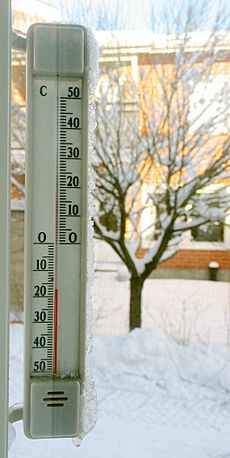Celsius facts for kids

The degree Celsius is a unit for measuring temperature. It's part of the Celsius temperature scale. This scale is named after a Swedish astronomer named Anders Celsius (1701–1744). He first suggested a version of it in 1742.
For many years, this unit was called centigrade. This name comes from Latin words: centum (meaning 100) and gradus (meaning steps). In 1948, the International Committee for Weights and Measures officially changed the name to "Celsius" to honor Anders Celsius. Most countries around the world use the Celsius scale. However, the Fahrenheit scale is still used in the United States and a few other places.
For a long time, the Celsius scale was set so that 0 °C was the temperature where water freezes. And 100 °C was the temperature where water boils. This was measured at normal air pressure. Interestingly, Anders Celsius's first idea was the opposite! He set 0 degrees for boiling water and 100 degrees for freezing water.
Today, the Celsius scale is linked to the kelvin scale. The kelvin is the main unit for temperature in science. The lowest possible temperature, called Absolute zero, is exactly 0 K. This is the same as −273.15 °C.
Contents
How the Celsius Scale Was Created
In 1742, a Swedish astronomer named Anders Celsius (1701–1744) created a temperature scale. His first scale was actually the reverse of what we use today. On his thermometer, 0 meant water was boiling, and 100 meant water was freezing.
Celsius wrote about his experiments. He showed that the melting point of ice doesn't change much with pressure. He also figured out how the boiling point of water changes with air pressure. He suggested that the 0 point on his scale (boiling water) should be set at the average air pressure at sea level. This is known as one standard atmosphere.
Changing the Scale Around
In 1743, a French scientist named Jean-Pierre Christin changed Celsius's scale. He flipped it so that 0 was the freezing point of water and 100 was the boiling point. Some people think Christin came up with this idea on his own. Others believe he simply reversed Celsius's original scale. He published his design for a "Thermometer of Lyon" using this new scale.
In 1744, around the time Anders Celsius passed away, another Swedish scientist, Carl Linnaeus (1707–1778), also reversed the scale. He had a special "Linnaeus-thermometer" made for his greenhouses. This thermometer used the scale we know today. Many scientists and instrument makers around that time also came up with this same reversed scale independently.
The first known Swedish document to use this modern Celsius scale was written by Linnaeus in 1745. He wrote about the temperatures inside the orangery (a type of greenhouse) at the University of Uppsala Botanical Garden.
Why "Celsius" Instead of "Centigrade"?
For a long time, people around the world, especially in science, used the term "centigrade scale." Temperatures were often just called "degrees" or "degrees centigrade," with the symbol °C.
However, in the French language, the word centigrade also means a small unit used for measuring angles. This could cause confusion between temperature and angle measurements. To fix this, in 1948, a big meeting of scientists (the 9th General Conference on Weights and Measures) officially decided to use "degree Celsius" for temperature.
Even though "Celsius" is the official name, some people in French and English-speaking countries still use "centigrade" informally. But its use has become less common over time. For example, in Australia, weather reports switched to only using Celsius after September 1, 1972. In the United Kingdom, BBC Weather started using "Celsius" instead of "centigrade" in February 1985.
Common Temperatures in Celsius
Here are some common temperatures and how they relate across different scales. These are measured at normal air pressure.
| Kelvin | Celsius | Fahrenheit | Rankine | |
|---|---|---|---|---|
| Absolute zero (coldest possible) | 0 K | −273.15 °C | −459.67 °F | 0 °R |
| Where Celsius and Fahrenheit are the same | 233.15 K | −40 °C | −40 °F | 419.67 °R |
| Boiling point of water | 373.1339 K | 99.9839 °C | 211.971 °F | 671.6410 °R |
| Boiling point of liquid nitrogen | 77.4 K | −195.8 °C | −320.4 °F | 139.3 °R |
| Melting point of ice | 273.1499 K | −0.0001 °C | 31.9998 °F | 491.6698 °R |
| Sublimation point of dry ice | 195.1 K | −78 °C | −108.4 °F | 351.2 °R |
| Common room temperature | 293 K | 20 °C | 68 °F | 528 °R |
| Average normal human body temperature | 310.15 K | 37.0 °C | 98.6 °F | 558.27 °R |
How to Convert Temperatures
- To change a temperature from degrees Celsius to kelvin, you need to add 273.15. For example, 0 degrees Celsius, which is when water freezes, is 273.15 kelvins.
- To change a temperature from kelvins to degrees Celsius, you need to subtract 273.15. For example, 310 K is about 36.85 °C, which is close to the temperature of a human body.
- To change a temperature from degrees Celsius to degrees Fahrenheit, you multiply it by 9/5 and then add 32. The formula is: F = (9/5)C + 32.
- To change a temperature from degrees Fahrenheit to degrees Celsius, you subtract 32 and then multiply the result by 5/9. The formula is: C = (F - 32) * 5/9.
Images for kids
-
An illustration of Anders Celsius's original thermometer. Notice the reversed scale: 100 is the freezing point of water and 0 is its boiling point.
See also
 In Spanish: Grado Celsius para niños
In Spanish: Grado Celsius para niños


